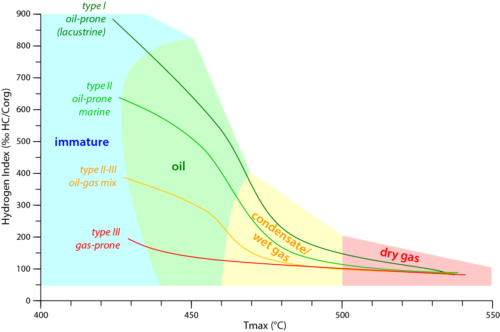Bulk CHNOS content & isotope ratios
Applications

This page is concerned with bulk elemental and isotopic analysis of oils/bitumen (whole samples or SARA fractions) and kerogen. Isotopic analysis concerning individual compounds can be found on other pages:
- The application of isotopic data for gases is intimately linked to molecular composition, so both aspects are discussed together in gas analysis.
- C isotopic analysis of individual alkanes in oil/bitumen is described on the CSIA page.
The major elemental composition of kerogen, particularly CHO, is useful in classifying the type of kerogen and its maturity, although it is often replaced by HI and OI values from Rock-Eval. Sulphur content and δ34S of oils/bitumen, and sulphate and sulphide in solid matter (including isolated kerogen) are usually measured at the same.
These analyses can be useful in determining the extent to which anaerobic conditions developed during source rock deposition and its influence on the type of hydrocarbons that are likely to be generated, as well as the timing of generation, given that C–S and S–S bonds are weaker than C–C and C–O bonds.
Bulk C stable isotopic data are routinely used to help characterize oils, extracts and kerogen. Sample size may dictate whether only a total oil/bitumen determination may be accomplished, although the δ13C values of SARA fractions in general, and of saturates and aromatics in particular, are helpful in correlating oils and their potential sources, and obtaining broad indications of depositional environment. Although shifts in bulk δ13C values of oils over geological time have been observed, source age inferences are difficult to make with any certainty. Data from a complete SARA analysis of an oil can be used to infer the source kerogen (and whole bitumen) value.
Hydrogen isotope ratios (δD) can also be obtained for bulk kerogen and oils/extracts. They are not routinely measured, but can be a useful correlation tool and may also yield indications of the balance between precipitation and evaporation during source deposition.
Sample requirements
Solvent-free total rock extract (EOM) or topped/untopped oil, solvent-free SARA fractions, and pre-extracted kerogen concentrate can all be analysed. The amount of sample required depends upon which elements are to be analysed and their concentrations in the sample: 0.2 mg is suitable for isolated SARA fraction δ13C determinations, but other analyses generally require 2–5 mg.
Analytical procedure
Preliminary preparation
Approximately 2–5 mg of sample is transferred to a pre-weighed tin capsule (5x8 mm), either in solid form or as a solution in dichloromethane (for oils, extracts and fractions), followed by evaporation of the solvent (50°C, ~1 h) and re-weighing.
O & H content
These analyses are performed by IFE at Kjeller.
Prepared samples (~5 mg) are pyrolyzed in a Hecatech high temperature pyrolysis unit at 1450°C. The produced H2 and CO is separated on a EuroVector Elemental Analyzer EA3028-IRMS and flushed into a NU-Instruments Horizon isotope ratio mass spectrometer (IRMS) for determination of O and H content, and δD. For δD, the GISP standard from IAEA is used (–189.73±0.9‰ VSMOW).
C & N content
Prepared samples are loaded into an automatic sampler, which is placed into a combustion reactor (Thermo Fisher Scientific Elemental Analyzer) at 1000°C. An excess supply of oxygen aids flash combustion of the capsules, resulting in a rise in temperature to 1700°C. The produced water is trapped on Mg(ClO4)2 (magnesium perchlorate) and CO2 is separated from N2 by a column and flashed into a Delta V Plus Isotope Ratio Mass Spectrometer (IRMS) (Thermo Fisher Scientific) via a Conflo IV interface. The amount of N and C are calculated on the basis of mass area of m/z 28 (N2) and 44 (CO2) and the δ13C determined.
With respect to δ13C, a standard (NSO-1, topped oil) is analyzed every 12th sample (δ13C –28.61‰ VPDB) for which the variation over three years has been ±0.09‰. All results are plotted on a calibration line calculated from analysis of international reference material analyzed in each batch of samples. For analytical control, a third reference material is run as unknown in all sequences. The value of this third reference material is reported with standard deviation to give accuracy and precision of the analysis.
Sulphur content & isotope ratio
These analyses are performed at IFE, Kjeller. An amount of V2O5 approximately equal to the sample weight (~5 mg) is added to ensure complete oxidation. The sample is then analysed using a EuroVector elemental analyser EA3028-IRMS. The procedure involves flash combustion of the samples at approximately 1700°C, reduction of SO3 to SO2 in the presence of Cu at 1030°C and separation of combustion products by gas chromatography using a Poraplot Q column.
The SO2 is transferred to a NU-Instruments Horizon isotope ratio mass spectrometer for determination of S content (from m/z 64 for SO2) and δ34S. NBS127 standard is analysed together with the samples (δ34S 20.3‰ CDT).
Potential problems
- Organic-based drilling-mud additives (e.g. diesel oil or glycols) in sufficient quantities will adversely affect C and H isotopic data for all bulk samples (CSIA may still be useful)
- Varying contributions from different sources will be averaged out in bulk data
- Oil and condensate from the same source unit may yield quite different bulk and saturates δ13C values due to the depletion of the higher boiling point range in the condensate
- Maturity variation has a relatively predictable influence on bulk δ13C values, but biodegradation can significantly affect values once most of the n-alkanes have been affected
References
Béhar F., Vandenbroucke M. (1987) Chemical modelling of kerogen. Organic Geochemistry 11, 15–24.
Killops S.D., Funnell R.H., Suggate R.P., Sykes R., Peters K.E., Walters C., Woolhouse A.D., Weston R.J., Boudou J.-P. (1998) Predicting generation and expulsion of paraffinic oil from vitrinite-rich coals. Organic Geochemistry 29, 1–21.
Sofer Z. (1984) Stable carbon isotope compositions of crude oils: application to source depositional environments and petroleum alteration. AAPG Bulletin 68, 31–49.
Stahl W.J. (1977) Carbon and nitrogen isotopes in hydrocarbon research and exploration. Chemical Geology 20, 121–149.